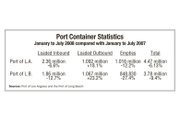Ports Take Their Show on the Road, Trying to Sell, Sell, Sell
With overall container traffic down at California’s ports, marketing executives are polishing their pitches to sell their facilities as the best place to ship cargo.
At the Port of Los Angeles, container traffic is expected to take a dip—after growing steadily between 1991 and 2006—because of consumer demand shrinking for things such as apparel, furniture and appliances. During the first seven months of this year, container volume was down a little more than 6 percent at the port while its neighbor port, the Port of Long Beach, experienced a 9.4 percent decline.
“There’s no question it is a very tough year for imports,” said Paul Bingham, an economist in Washington, D.C., who tracks traffic at the nation’s ports for Global Insight Inc., an economic and political consulting firm based outside of Boston in Waltham, Mass. “The last recession, in 2001, was driven by business, not by consumers, which means you didn’t have as big of an effect as you do on container volumes.”
The one thing that has been keeping ports afloat this year is the dramatic rise in exports. At the Port of Los Angeles, the number of cargo containers being exported shot up 18 percent during the first seven months of this year, while at the Port of Long Beach, they rose a little more than 23 percent.
That was seen in apparel and fabric. While apparel imports were down nearly 12 percent at the Port of Los Angeles during the first five months of this year, fabric exports jumped nearly 40 percent. Doing even better were products such as fresh and frozen meat exports, which saw a hefty 125 percent increase.
“Exports have kept us out of a recession,” Bingham said. But he noted that our major trading partners, particularly Japan and Western Europe, are starting to see some softness in their economies. “The pace of growth in exports is not likely to continue the way we have seen it.”
Global Insight is predicting a bigger slowdown in the economy in the fourth quarter of 2008 and the first quarter of 2009 now that tax stimulus checks have been spent and stubbornly high gas prices are nudging up the price of everything from corn to coffeemakers. “This isn’t going to turn around fast,” Bingham said.
Marketing mania
While business at the ports isn’t expected to increase before next year, the ports are busy trying to market their gateways as the best place to ship goods.
The Port of Los Angeles has a broad marketing plan that encompasses everything from seminars on shipping for students at the Fashion Institute of Design & Merchandising in downtown Los Angeles to maintaining good relations with shipping lines and their overseas offices.
Jim MacLellan, director of trade services at the Port of Los Angeles, said the port works on increasing business by talking to several groups to promote the Port of Los Angeles. Those groups include the Foreign Trade Association in Los Angeles, the Los Angeles Customs Brokers and Freight Forwarders Association, the Los Angeles Chamberof Commerce, the U.S. Department of Commerce and several foreign chambers of commerce based in Los Angeles. “I’m running around like crazy trying to get people to work together,” MacLellan said.
The Port of Long Beach is concentrating on adding new terminals to generate more business. “We are taking advantage of a lull in import business and moving forward with our terminal-redevelopment project, called Middle Harbor Redevelopment Project,” said Chris Lytle, the port’s deputy executive director. The port has completed its draft environmental-impact report for the $750 million project, which would reconfigure some old and outdated container-shipping terminals.
At the Port of Oakland, where overall container business was down 2.8 percent during the first seven months of this year, port executives are helping to market nearby distribution centers in the Central Valley region to grow business. “We believe the growth in distribution centers in the Central Valley would be good for importers in terms of efficiency for goods to be transferred inland via truck or rail,” said Marilyn Sandifur, a spokesperson for the Port of Oakland.
For example, Oakland is touting a huge distribution center being constructed south of Stockton, Calif., near that town’s municipal airport, about 70 miles from the port. The project, called Opus Logistics Center by the Opus West Corp., encompasses more than 400 acres with the possibility of more than 8 million square feet of warehouses. Two large distribution centers should be completed by the end of November.
Free for all
In the near future, Southern California’s ports are banking on a number of new freetrade agreements being finalized, leading to more goods being shipped from the Los Angeles area to overseas destinations and vice versa.
Maurice Kogon, director of the Center for International Trade Development at El Camino College in Torrance, Calif., said a free-trade agreement with South Korea would be extremely beneficial to the local ports and several California industries, particularly the apparel sector. The United States and South Korea signed a free-trade agreement in June 2007. It now must be approved by Congress.
“If a Korean free-trade agreement passes, import duties on apparel will go from 13 percent to zero,” Kogon said. “This would be nothing if Korea wasn’t a good market. But it’s an importing country, and apparel has a good opportunity there. It gives the United States a competitive advantage.”
Kogon noted that more than one-third of the $2.9 billion in fashion apparel exported from the United States last year came from California.






















